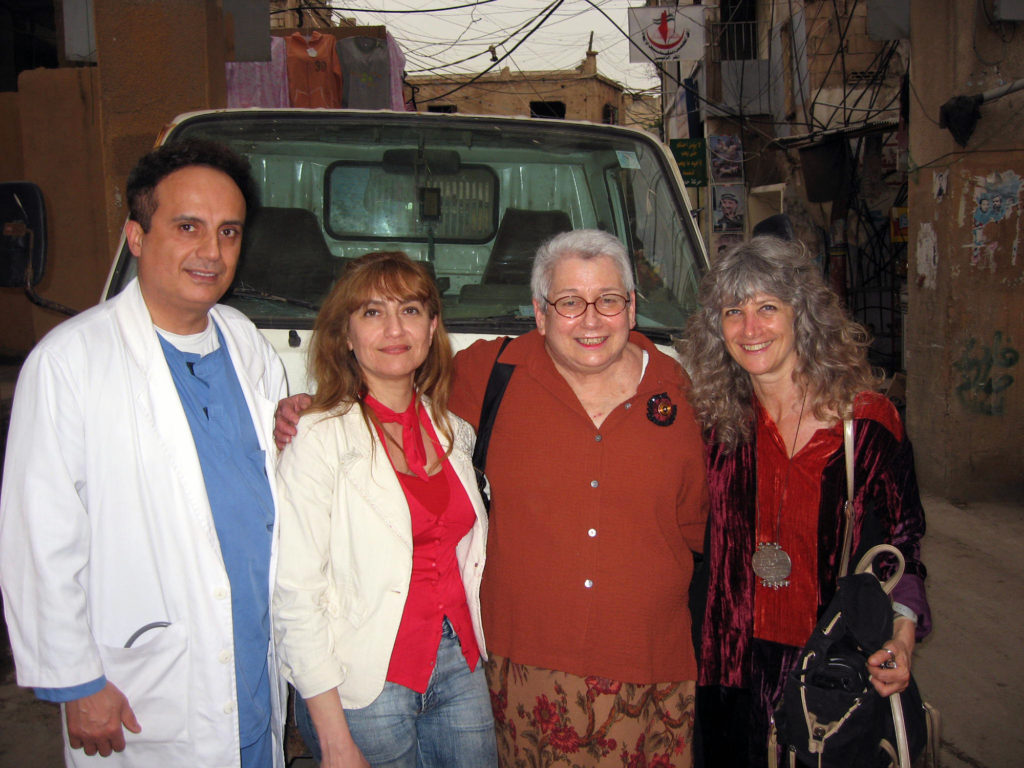I’ve never left that hospital room in Burj El Barajneh
Posted in: peopleofanera
I was born toward the end of the Holocaust. I went to Hebrew school, marked all the Jewish holidays, and then went to a Jewish school of nursing. In 1967, I was asked to go volunteer in Israel. I didn’t know much about the politics there, but I heard there were Palestinians who were living in tents—it was all very hazy. So, I chose to stay in the United States.
Politically, there was a lot going on in the 1960s. I joined the Vietnam anti-war movement, the women’s movement, and the civil rights movement. Most people had their plates full, and they would not deal with this “Palestinian issue”. Very few people could even define what it was. In 1972, I decided, along with a friend, to go overseas and travel. We wanted to go to the Middle East to see what this Palestinian “thing” was about. It sounds very impulsive now, but we really needed to see things how they were, and especially do so on our own terms.
Shortly after we arrived in Beirut, we asked to go to a refugee camp. We got a taxi. Someone had written down the name of the refugee camp: Burj El Barajneh. This was 1972. While we were in the camp, we heard that someone had just killed Israelis at Munich. Israel bombed Lebanon in retaliation. I immediately called the Red Cross/Crescent and told them I was a nurse, and I volunteered to help.
When I went to the south of Lebanon, I saw the Palestinians’ horrific living conditions. The mutilation from the bombings was terrible and widespread. I had traveled to Lebanon to get an introduction to Israel and Palestine, and this was what I found. Still, I knew I needed to learn more. I stayed in Lebanon for a couple of months, read a great deal, met a lot of people, and then decided I was going to go to Israel to work on a kibbutz.
When I arrived in Israel, I was surrounded by green grass, swimming pools, and flowers. I could not get over the disparity between what I had just seen and the place I was in now.
Eventually I came back to the United States and things were quite surreal. The conversations about Palestinian refugees still hadn’t begun. Many of us back then faced a question about the future: how could we get people to mobilize around these refugees? I grew up in a time and a culture where speaking the truth was the most important thing you could do. If you see something that’s an atrocity, you had to speak up against it. It’s because I’m Jewish that I hold these values and care so much about refugees. These principles are deep in the history of my people. We have a high moral compulsion to do what’s fair, and what’s just.
Fortunately, someone introduced me to Anera. At the time in the United States, Anera was the organization that helped these refugees. I knew I had found the right people because this wasn’t just a march down Pennsylvania Avenue. Anera prioritized hiring Palestinian staff, keeping their field offices in the Middle East local and staying tuned into life in refugee camps.


Ellen Siegel (second from right) visits with Anera staff and local partners in Shatila Palestinian refugee camp.
In the years past, I’ve been to Jerusalem, I’ve been to the West Bank and Gaza, and I’ve seen the work Anera has done, and the absolutely wonderful staff they have. I’ve been to their clinics, and seen the physicians they work with examining children. As a nurse, I know high-quality care and procedures when I see them, and Anera’s partners are always doing exceptional work.
If I could send someone anywhere to see what Anera’s all about, I’d send them to Hani’s warehouse in the West Bank. When you enter, it seems almost under-stocked, entirely because Hani (and his team) is wonderfully quick at distribution. He’s incredibly devoted and everything in there is always in perfect shape. It’s his job, but it’s also his community. Anera makes sure to find partners who share in the stakes of their work.
If there is anything I can say about the year to come, and about the refugees’ history, it starts with a memory of Lebanon. I remember going to Haifa Hospital in a refugee camp close to Beirut once in 1972. A patient, an old man, was laid up in bed. He had pictures on his wall of an olive orchard. He was Palestinian. He was born in Palestine. He remembered his home in Palestine. And that was his orchard on the wall. I returned to the US eventually. New years brought changes. More generations have grown up in the camp. And Anera’s work has expanded as needs have grown. But the old man’s story has stayed with me through the years. He never left his orchard, just as I’ve never left that hospital room in Burj El Barajneh.
We can define our futures by the memories we hold the closest, the legacies we keep alive, and the homes we vow to see again. These things weather hardship and chaos. They are at the heart of the resilience you can see in every refugee community. Few organizations know this as well as Anera, and it’s why I’m proud to mark another year of life-changing work with them.
OUR BLOG
Related
In this log, Anera provides updates on unfolding war in Palestine and our response. In some cases, additional activities may be added retroactively to the daily entries as we receive additional program reporting. Questions? See our FAQ page July 10,…
